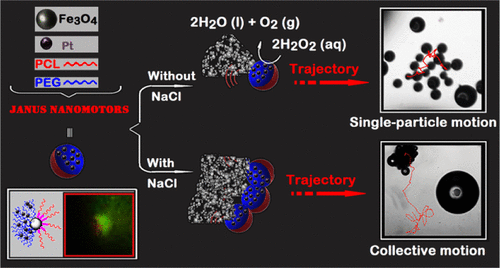Our official English website, www.x-mol.net, welcomes your
feedback! (Note: you will need to create a separate account there.)
Self-/Magnetic-Propelled Catalytic Nanomotors Based on a Janus SPION@PEG-Pt/PCL Hybrid Nanoarchitecture: Single-Particle versus Collective Motions
Langmuir ( IF 3.7 ) Pub Date : 2021-08-30 , DOI: 10.1021/acs.langmuir.1c01166 Sepideh Khoee 1 , Samaneh Moayeri 1 , Mohammad A Charsooghi 2
Langmuir ( IF 3.7 ) Pub Date : 2021-08-30 , DOI: 10.1021/acs.langmuir.1c01166 Sepideh Khoee 1 , Samaneh Moayeri 1 , Mohammad A Charsooghi 2
Affiliation

|
In this paper, we synthesized superparamagnetic iron oxide nanoparticles (NPs) functionalized with (3-aminopropyl)triethoxysilane (Fe3O4@APTES). The synthesized NPs were coated with succinic anhydride (Fe3O4@COOH) in the next step. Half the surface of the NPs was shielded with wax microparticles via the Pickering emulsion technique, and the unshielded side was covered with poly(ethylene glycol) methyl ether. Platinum nanoparticles (Pt NPs) were deposited between PEG chains by the oxidation-reduction method through an in situ procedure to obtain a metal–polymer composite. These deposited Pt NPs have the potential to catalyze the decomposition of hydrogen peroxide at the surface of Janus nanomotors (JNMs). After de-waxing of the NPs, Irgacure 2959 (as the initiator) was reacted with the bare side of the NPs to provide the opportunity to grow poly(ε-caprolactone) (PCL) chains on the surface of the nanomotors through the “grafting from” method. The diffusion coefficient and velocity of the JNMs (before and after the PCL reaction) in the aqueous solution of 1, 2, 3, 5, and 10% (w/w) hydrogen peroxide and in the presence of different concentrations of NaCl solutions (0, 5, and 10% (w/v)) were investigated by mean square displacement analysis for single-particle or collective motions of JNMs. In addition, the simultaneous effect of an external magnetic field and the NaCl concentration on the movement direction of JNMs was also evaluated in the presence of hydrogen peroxide (10%). Increasing the ionic strength through NaCl addition permits the JNMs to move with relatively lower amounts of fuel [i.e., 2% (w/w)]. The collective motion investigation of the JNMs showed the highest speed in the media with 10% (w/w) hydrogen peroxide and 5% (w/v) NaCl solution (about 1215.78 μm2/s) due to the surfactant effect of the Janus architecture.
中文翻译:

基于 Janus SPION@PEG-Pt/PCL 混合纳米结构的自驱动/磁驱动催化纳米马达:单粒子与集体运动
在本文中,我们合成了用(3-氨基丙基)三乙氧基硅烷(Fe 3 O 4 @APTES)功能化的超顺磁性氧化铁纳米颗粒(NPs )。合成的纳米颗粒被琥珀酸酐(Fe 3 O 4@COOH)在下一步。纳米颗粒的一半表面通过皮克林乳液技术用蜡微粒屏蔽,未屏蔽的一面用聚(乙二醇)甲基醚覆盖。铂纳米粒子(Pt NPs)通过氧化还原法通过原位程序沉积在PEG链之间,以获得金属-聚合物复合材料。这些沉积的 Pt NPs 有可能在 Janus 纳米马达 (JNM) 的表面催化过氧化氢的分解。NPs 脱蜡后,Irgacure 2959(作为引发剂)与 NPs 的裸侧反应,提供机会通过“接枝”在纳米马达表面生长聚(ε-己内酯)(PCL)链从”方法。JNMs(PCL 反应前后)在 1、2、3、5 和 10% (w/w) 过氧化氢水溶液中以及不同浓度 NaCl 溶液中的扩散系数和速度( 0、5 和 10% (w/v)) 通过均方位移分析对 JNM 的单粒子或集体运动进行研究。此外,还在过氧化氢 (10%) 存在下评估了外部磁场和 NaCl 浓度对 JNM 运动方向的同时影响。通过添加 NaCl 增加离子强度允许 JNMs 以相对较少的燃料量移动。和 10% (w/v)) 通过均方位移分析对 JNM 的单粒子或集体运动进行了研究。此外,还在过氧化氢 (10%) 存在下评估了外部磁场和 NaCl 浓度对 JNM 运动方向的同时影响。通过添加 NaCl 增加离子强度允许 JNMs 以相对较少的燃料量移动。和 10% (w/v)) 通过均方位移分析对 JNM 的单粒子或集体运动进行了研究。此外,还在过氧化氢 (10%) 存在下评估了外部磁场和 NaCl 浓度对 JNM 运动方向的同时影响。通过添加 NaCl 增加离子强度允许 JNMs 以相对较少的燃料量移动。即,2% (w/w)]。由于 Janus 的表面活性剂效应,JNM 的集体运动研究表明,在含有 10% (w/w) 过氧化氢和 5% (w/v) NaCl 溶液(约 1215.78 μm 2 /s)的介质中速度最高建筑学。
更新日期:2021-09-14
中文翻译:

基于 Janus SPION@PEG-Pt/PCL 混合纳米结构的自驱动/磁驱动催化纳米马达:单粒子与集体运动
在本文中,我们合成了用(3-氨基丙基)三乙氧基硅烷(Fe 3 O 4 @APTES)功能化的超顺磁性氧化铁纳米颗粒(NPs )。合成的纳米颗粒被琥珀酸酐(Fe 3 O 4@COOH)在下一步。纳米颗粒的一半表面通过皮克林乳液技术用蜡微粒屏蔽,未屏蔽的一面用聚(乙二醇)甲基醚覆盖。铂纳米粒子(Pt NPs)通过氧化还原法通过原位程序沉积在PEG链之间,以获得金属-聚合物复合材料。这些沉积的 Pt NPs 有可能在 Janus 纳米马达 (JNM) 的表面催化过氧化氢的分解。NPs 脱蜡后,Irgacure 2959(作为引发剂)与 NPs 的裸侧反应,提供机会通过“接枝”在纳米马达表面生长聚(ε-己内酯)(PCL)链从”方法。JNMs(PCL 反应前后)在 1、2、3、5 和 10% (w/w) 过氧化氢水溶液中以及不同浓度 NaCl 溶液中的扩散系数和速度( 0、5 和 10% (w/v)) 通过均方位移分析对 JNM 的单粒子或集体运动进行研究。此外,还在过氧化氢 (10%) 存在下评估了外部磁场和 NaCl 浓度对 JNM 运动方向的同时影响。通过添加 NaCl 增加离子强度允许 JNMs 以相对较少的燃料量移动。和 10% (w/v)) 通过均方位移分析对 JNM 的单粒子或集体运动进行了研究。此外,还在过氧化氢 (10%) 存在下评估了外部磁场和 NaCl 浓度对 JNM 运动方向的同时影响。通过添加 NaCl 增加离子强度允许 JNMs 以相对较少的燃料量移动。和 10% (w/v)) 通过均方位移分析对 JNM 的单粒子或集体运动进行了研究。此外,还在过氧化氢 (10%) 存在下评估了外部磁场和 NaCl 浓度对 JNM 运动方向的同时影响。通过添加 NaCl 增加离子强度允许 JNMs 以相对较少的燃料量移动。即,2% (w/w)]。由于 Janus 的表面活性剂效应,JNM 的集体运动研究表明,在含有 10% (w/w) 过氧化氢和 5% (w/v) NaCl 溶液(约 1215.78 μm 2 /s)的介质中速度最高建筑学。










































 京公网安备 11010802027423号
京公网安备 11010802027423号